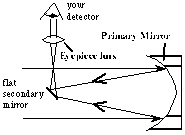

| Brief History | | | Simple Optics | | | Refractive Telescopes | | | Reflective Telescopes | | | Reference & Links |
Reflector
How Reflector Telescopes Work
The main difference between a refractor and a reflector is the latter telescope involves both refraction and reflection of light rays. Reflector telescopes uses two mirrors (primary and secondary mirror) as well as a glass lens (eyepiece lens) in their lens system. Similar to refractors, light rays are gather through the aperture. However instead of bending the rays through a glass lens immediately, rays are to travel to the back of the telescope where the primary mirror is located. The primary mirror is shaped parabolically so that all incoming parallel rays will reflect off the mirror at their own specific angle and hit the surface of the secondary mirror. Once again a reflection will occur and all the rays will converge to a single point call the focal point. It is from that point where optics of refractors and reflectors are common. Light rays will continue to travel and refracts at the eyepiece lens and forms an image that is magnified to people's perception. However this image is also in reverse to the original image. Refer to the following diagram to understand the components and processes in which light rays travel through a reflector telescope.

Advantages/Disadvantages
Advantages of a reflector telescopes
Page developed by Leo S.K. Cheng